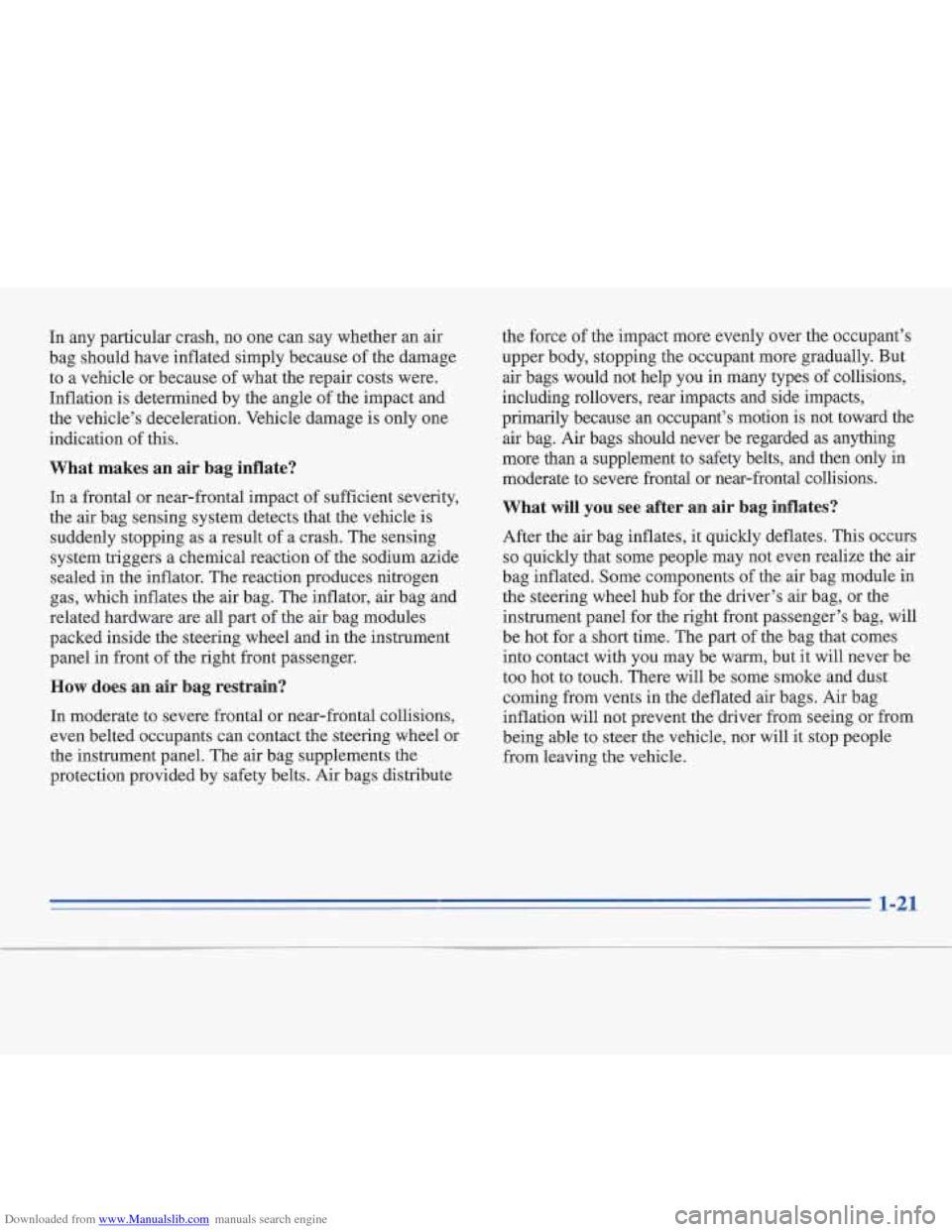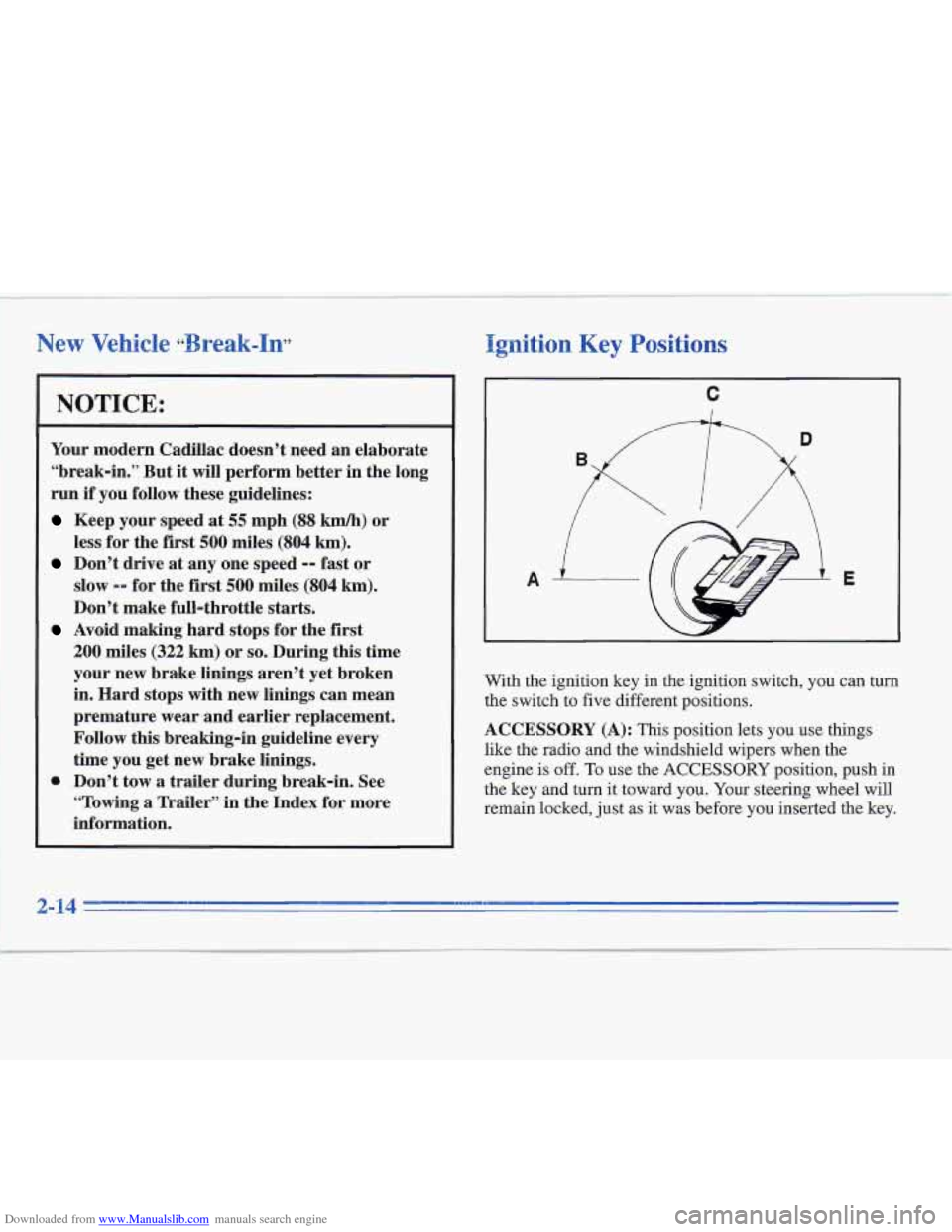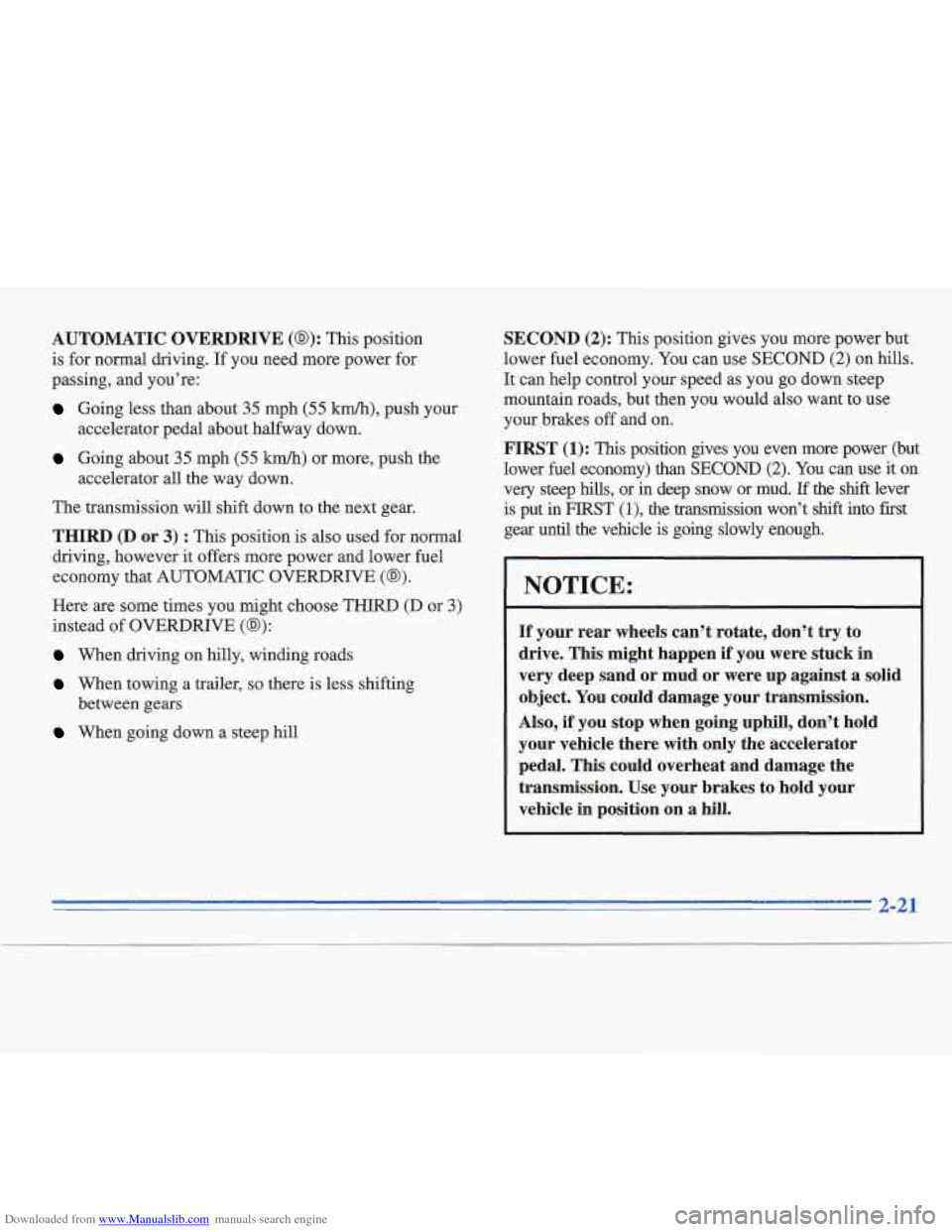1996 CADILLAC FLEETWOOD tow
[x] Cancel search: towPage 36 of 306

Downloaded from www.Manualslib.com manuals search engine In any particular crash, no one can say whether an air
bag should have inflated simply because of the damage
to a vehicle or because of what the repair costs were.
Inflation is determined by the angle of the impact and
the vehicle’s deceleration. Vehicle damage is only one
indication of this.
What makes an air bag inflate?
In a frontal or near-frontal impact of sufficient severity,
the air bag sensing system detects that the vehicle is
suddenly stopping as a result of a crash. The sensing
system triggers a chemical reaction of
the sodium azide
sealed in the inflator. The reaction produces nitrogen
gas, which inflates the air bag. The inflator, air bag and
related hardware
are all part of the air bag modules
packed inside the steering wheel and in the instrument
panel in front of the right front passenger.
How does an air bag restrain?
In moderate to severe frontal or near-frontal collisions,
even belted occupants can contact the steering wheel or
the instrument panel. The air bag supplements the
protection provided by safety belts. Air bags distribute the force
of the impact more evenly over the occupant’s
upper body, stopping the occupant more gradually. But
air bags would not help you
in many types of collisions,
including rollovers, rear impacts and side impacts,
primarily because an occupant’s motion is not toward the
air bag.
Air bags should never be regarded as anything
more than a supplement to safety belts, and then
only in
moderate to severe frontal or near-frontal collisions.
What will you see after an air bag inflates?
After the air bag inflates, it quickly deflates. This occurs
so quickly that some people may not even realize the air
bag inflated. Some components of the air bag module in
the steering wheel hub for the driver’s air bag, or the
instrument panel for
the right front passenger’s bag, will
be hot for a short time. The part of the bag that comes
into contact with you may be warrn, but it will never be
too hot to touch. There will be some smoke and dust
coming from vents in the deflated air bags. Air bag
inflation will not prevent
the driver from seeing or fiom
being able to steer the vehicle,
nor will it stop people
from leaving the vehicle.
1-21
Page 57 of 306

Downloaded from www.Manualslib.com manuals search engine I
Never do this.
Here two children are wearing the same belt. The
belt can’t properly spread the impact forces.
In a
crash, the two children can be crushed together
and seriously injured.
A belt must be used by
only one person
at a time.
Q: What if a child is wearing a lap-shoulder belt,
but the child is
so small that the shoulder belt is
very close to the child’s face or n-eck?
A: Move the child toward the center of the vehicle, but
be sure that the shoulder belt still is on the child’s
shoulder,
so that in a crash the child’s upper body
would have the restraint that belts provide.
If the
child is
so small that the shoulder belt is still very
close
to the child’s face or neck, you might want to
place the child in the center seat position, the one
that has only
a lap belt.
1-42
Page 73 of 306

Downloaded from www.Manualslib.com manuals search engine Ignition Key Positions
NOTICE:
Your modern Cadillac doesn’t need an elaborate
“break-in.” But
it will perform better in the long
run
if you follow these guidelines:
Keep your speed at 55 mph (88 km/h) or
less for the first
500 miles (804 km).
Don’t drive at any one speed -- fast or
slow
-- for the first 500 miles (804 km).
Don’t make full-throttle starts.
200 miles (322 km) or so. During this time
your new brake linings aren’t yet broken
in. Hard stops with new linings can mean
premature wear and earlier replacement.
Follow this breaking-in guideline every
time you get new brake linings.
* Don’t tow a trailer during break-in. See
“Towing a Trailer” in the Index for more
information.
Avoid making hard stops for the first
C
A E
With the ignition key in the ignition switch, you can turn
the switch to five different positions.
ACCESSORY (A): This position lets you use things
like the radio and the windshield wipers when the
engine is off.
To use the ACCESSORY position, push in
the key and turn it toward you. Your steering wheel will
remain locked, just
as it was before you inserted the key.
Page 76 of 306

Downloaded from www.Manualslib.com manuals search engine Starting Your 5.7 Liter LTl Engine
1. Without pushing the accelerator pedal, turn the ignition key to START. When the engine starts, let
go of
the key. The idle speed will go down as your
engine gets warm.
NOTICE:
Holding your key in START for longer than
15 seconds at a time will cause your battery to be
drained much sooner. And the excessive heat can
damage your starter motor.
2. If it doesn’t start within 10 seconds, push the
accelerator pedal all the way to the floor, while you
hold the ignition key in START. When the engine
starts, let
go of the key and let up on the accelerator
pedal. Wait about
15 seconds between each try to
help avoid draining your battery.
When starting your engine in very cold weather (below
0°F or -18”C), do this:
1. With your foot off the accelerator pedal, turn the
ignition key to START and hold
it there. When the
engine starts, let
go of the key. Use the accelerator pedal
to maintain engine speed, if you have to, until
your engine has run for a while.
2. If your engine still won’t start (or starts but then
stops), it could be flooded with too much gasoline.
Try pushing your accelerator pedal all the way to the
floor and holding it there as you hold the key in
START for about three seconds.
If the vehicle starts
briefly but then stops again, do the same thing, but
this time keep the pedal down for five or six seconds.
This clears the extra gasoline from the engine.
NOTICE:
Your engine is designed to work with the
electronics in your vehicle.
If you add electrical
parts or accessories, you could change the way
the engine operates. Before adding electrical
equipment, check with your dealer.
If you don’t,
your engine might not perform properly.
If you ever have to have your vehicle towed, see
the part of this manual that tells how to do it
without damaging your vehicle. See “Towing
Your Vehicle” in the Index.
Page 80 of 306

Downloaded from www.Manualslib.com manuals search engine AUTOMATIC OVERDRIVE (@): This position
is for normal driving.
If you need more power for
passing, and you’re:
Going less than about 35 mph (55 km/h), push your
Going about 35 mph (55 km/h) or more, push the
The transmission will shift down to the next gear.
accelerator pedal
about halfway down.
accelerator all the way down.
THIRD (D or 3) : This position is also used for normal
driving, however it offers more power and lower fuel
economy that AUTOMATIC OVERDRIVE
(@).
Here are some times you might choose THIRD (D or 3)
instead of OVERDRIVE (@):
When driving on hilly, winding roads
When towing a trailer, so there is less shifting
When going down a steep hill
between gears
SECOND (2): This position gives you more power but
lower fuel economy. You can use SECOND
(2) on hills.
It can help control your speed as you
go down steep
mountain roads, but then you would
also want to use
your brakes
off and on.
FIRST (1): This position gives you even more power (but
lower fuel economy)
than SECOND (2). You can use it on
very steep hills, or in deep snow or mud. If the shift lever
is put in
FIRST (l), the transmission won’t shift into first
gear until the vehicle is going slowly enough.
NOTICE:
If your rear wheels can’t rotate, don’t try to
drive. This might happen
if you were stuck in
very deep sand
or mud or were up against a solid
object. You could damage your transmission.
Also,
if you stop when going uphill, don’t hold
your vehicle there with only the accelerator
pedal. This could overheat and damage the
transmission. Use your brakes to hold your
vehicle in position on a hill.
Page 83 of 306

Downloaded from www.Manualslib.com manuals search engine 4
2. Move the shift lever into PARK (P) position
like this:
Pull the lever toward you.
3.
4.
5.
Move the lever up as far as it will go.
With your right foot still holding the brake pedal
down, set the parking brake.
Turn the ignition key to
LOCK.
Remove the key and take it with you. If you can
leave your vehicle with the ignition key in your
hand, your vehicle is
in PARK (P).
2-24
Page 84 of 306

Downloaded from www.Manualslib.com manuals search engine Leaving Your Vehicle With the
Engine Running
I I
It can be dangerous to leave your vehicle with the
engine running. Your vehicle could move
suddenly
if the shift lever is not fully in PARK (P)
with the parking brake firmly set. And, if you
leave the vehicle with the engine running,
it could
overheat and even catch fire. You or others could
be injured. Don’t leave your vehicle with the
~ engine running unless you have to.
I
If you have to leave your vehicle with the engine
running, be sure your vehicle is in PARK (P) and your
parking brake is firmly set before you leave it. After
you’ve moved the shift lever into the PARK
(P)
position, hold the regular brake pedal down. Then, see if
you can move the shift lever away from PARK
(P)
without first pulling it toward you. If you can, it means
that
the shift lever wasn’t fully locked into PARK (P).
2-25
Page 90 of 306

Downloaded from www.Manualslib.com manuals search engine lhrr Signal and Lane Change Indicator
To signal a turn, move the lever all the way up or down.
When the turn is finished, the lever will return
automatically.
An arrow on the
instrument panel
will flash in the
direction of the
turn or lane change.
To signal a lane change, just raise or lower the lever
until the arrow starts to flash. Hold it there until you
complete your lane change. The lever will return by
itself when you release it. As you
signal a turn or a lane change, if the arrows flash
faster than normal, a signal bulb may be burned out and
other drivers won’t see your turn signal.
If a bulb is
burned out, replace it to help avoid an accident. If the
arrows don’t go on at all when you signal a turn, check
the fuse (see “Fuses and Circuit Breakers”
in the Index)
and for burned-out bulbs.
If for some reason, your turn signal
is left on, a chime
will sound (after having driven about
a half of a mile) to
remind you to turn if off.
If you have a trailer towing option with added wiring for
the trailer lamps, a different turn signal flasher
is used.
With this flasher installed, the signal indicator will flash
even if a turn signal bulb is burned out. Check the front
and rear turn signal lamps regularly to make sure they
are working.
2-31